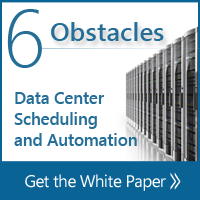Gartner’s Data Center Conference
Last week Gartner VP and distinguished analyst Ronni Colville gave a presentation at Gartner’s Data Center Conference entitled Automation: The Linchpin for Cloud & Data Centers. In it, she presented the concept that IT organizations are taking an “opportunistic” approach to automation by identifying automation opportunities as they arise and implementing platform-specific tools to solve those problems. It was a similar presentation to the one Colville gave at the Gartner Infrastructure and Operations Conference in June, so I won’t repeat the information already talked about in the first post, but rather focus on the new concepts and interesting poll results Colville presented last week.
Colville talked about how “content is king” for workload automation vendors. The focus has shifted from providing script-based schedulers to providing “content,” or “templated” job steps for common IT functions, applications, platforms and more. It means less customization and less scripting for IT organizations as IT automation moves towards GUI-based workflow designers that place an emphasis on reusability and being designed for change.
Additionally, large organizations are recognizing the need to take an architectural approach to IT automation, and as such, are beginning to construct automation teams and/or assign automation directors, according to Colville. These professionals are responsible for adopting a “systematic” approach to IT automation by identifying the various silos of automation and unifying/consolidating them via enterprise scheduling and automation solutions.
This is almost certainly a good thing, as conversations with clients have shown that IT automation in most enterprise organizations is still 75% manual…aka scripting…according to Gartner. “Those scripts are there, you might not know it, but they’re there. You have to develop an automation strategy that is more reliable,” Colville says. This statistic was underscored by a series of audience polls taken during the presentation:
Where Does Your Automation Live?
32% – In the operating system level (batch and scripts)
27% – In job schedulers or workload automation
10% – In configuration and provisioning or application release automation
17% – In IT process automation tools
8% – In cloud management platform tools
2% – None
2% – Don’t know
What is Your Highest Priority Focus for IT Operations Automation for the Next 12 to 18 Months?
55% – Provisioning and Configuration
13% – Fault and event
13% – Cloud projects
9% – High availability
7% – Disaster recovery
1% – Don’t know
IT organizations continue to wrestle with silos of automation and the opportunity exists for IT leaders to harness the elemental deployment of point automation tools by adopting an architectural approach. That message has clearly begun to resonate within the marketplace, as conversations with Data Center conference attendees, prospects and customers of ActiveBatch alike have shown the discussion is being elevated and IT organizations are recognizing the value of adopting an enterprise-grade strategy to IT automation.

